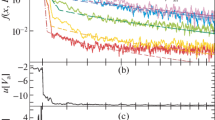Abstract
The applicability of a new model in terms of the description of real gas effects in the Direct Simulation Monte Carlo method is analysed. The model is used in a numerical study of the internal structure of the front of a strong shock wave and relaxation zone behind the front for conditions corresponding to spacecraft entry into the Martian atmosphere. The influence of the free-stream parameters on relaxation of various energy modes of molecules in the wave front and in the relaxation region is considered. The effect of chemical reactions on the flow structure is studied. A detailed analysis of flow nonequilibrium is performed at the level of the velocity distribution function and population of rotational and vibrational levels of molecules.
Similar content being viewed by others
References
G.A. Bird, Molecular Gas Dynamics and the Direct Simulation of Gas Flows, Clarendon Press, Oxford, 1994.
S.F. Gimelshein, N.E. Gimelshein, D.A. Levin, M.S. Ivanov, and I.J. Wysong, On the use of chemical reaction rates with discrete internal energies in the direct simulation Monte Carlo method, Physics of Fluids, 2004, Vol. 16, Iss. 7, P. 2442–2451.
F. Bergemann and I.D. Boyd, DSMC simulation of inelastic collisions using the Borgnakke — Larsen method extended to discrete distribution of vibrational energy, in: Rarefied Gas Dynamics: Theory and Simulations, 1994, Vol. 158, P. 174–183.
M.S. Ivanov, G.N. Markelov, and S.F. Gimelshein, Statistical simulation of reactive rarefied flows: numberical approach and applications, AIAA Paper No. 98-2669, 1998.
B.L. Haas, D. Hash, G.A. Bird, F.E. Lumpkin, and H. Hassan, Rate of thermal relaxation in direct simulation Monte Carlo methods // Phys. Fluids A, 1994, Vol. 6, No. 6, P. 2191–2201.
J.H. Jeans, The Dynamical Theory of Gases, Cambridge University Press, London, 1916.
V.A. Gorelov, M.K. Gladyshev, A.Yu. Kireev, and S.V. Shilenkov, Nonequilibrium molecular radiation near a space vehicle at the Martian atmosphere entry, Proc. 4th European Symp. on Aerothermodyn. Space Vehicles (Capua, Italy, 15–18 October, 2001), SP-487, European Space Agency, 2002, P. 123–135.
V. Gromov and S. Surzhikov, Convective and radiative heating of Martian space vehicle base surface, Proc. 4th European Symp. on Aerothermodyn. Space Vehicles P. 265–269.
J.N. Moss, R.G. Wilmoth, and J.M. Price, DSMC simulation of blunt body flows for Mars entries: Mars Pathfinder and Mars Microprobe capsules, AIAA Paper No. 97-2508, 1997.
Author information
Authors and Affiliations
Additional information
This work was financially supported by the Russian Foundation for Basic Research (Grant No. 06-08-00687-a), the ISTC Project No. 2298p, and by SB RAS Integration Project No. 2, 2003.
Rights and permissions
About this article
Cite this article
Bondar, Y.A., Gimelshein, S.F., Markelov, G.N. et al. Direct statistical Monte Carlo simulation of the shock-wave structure in dissociating gas. Thermophys. Aeromech. 13, 239–256 (2006). https://doi.org/10.1134/S0869864306020077
Received:
Issue Date:
DOI: https://doi.org/10.1134/S0869864306020077




